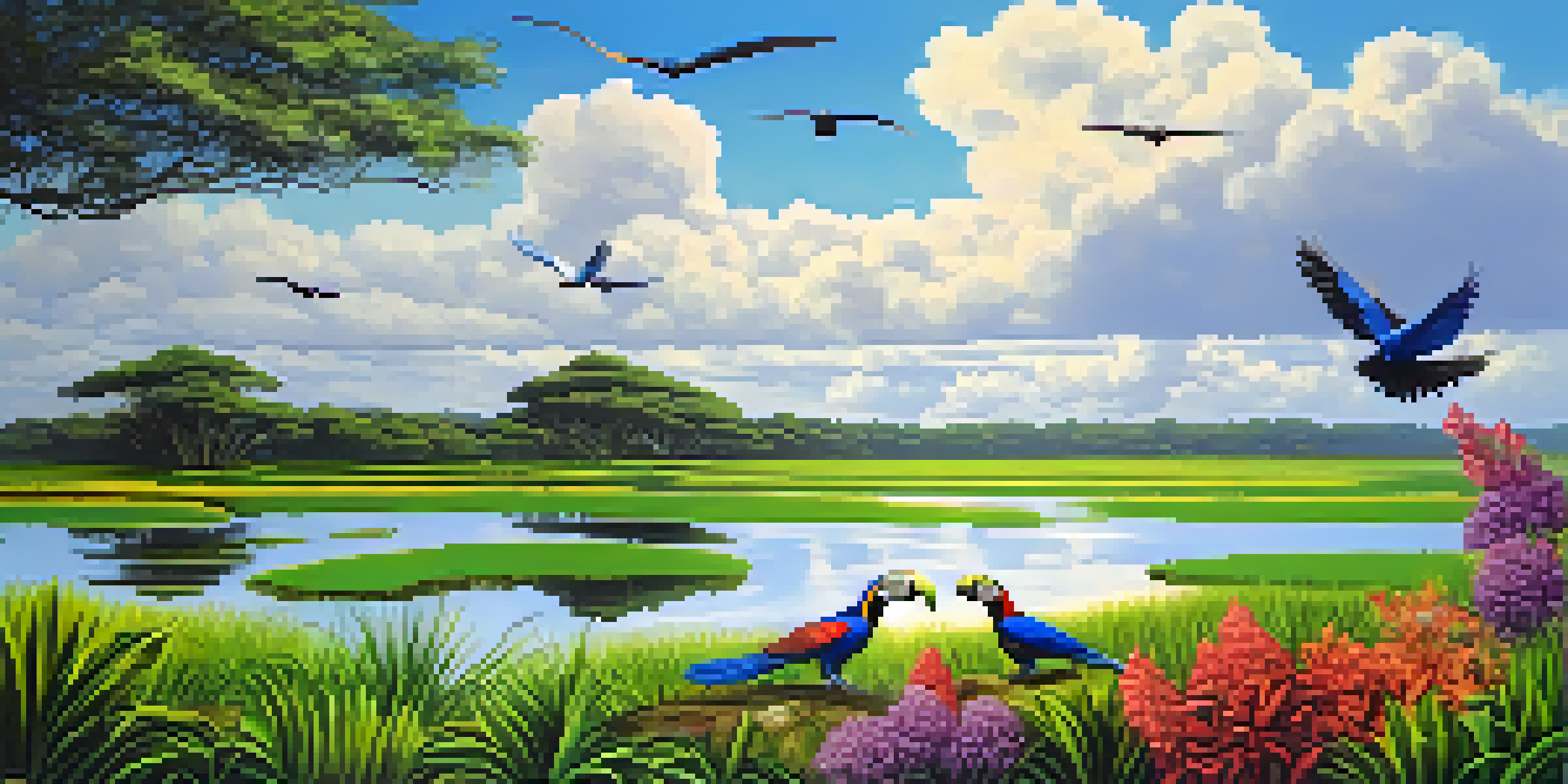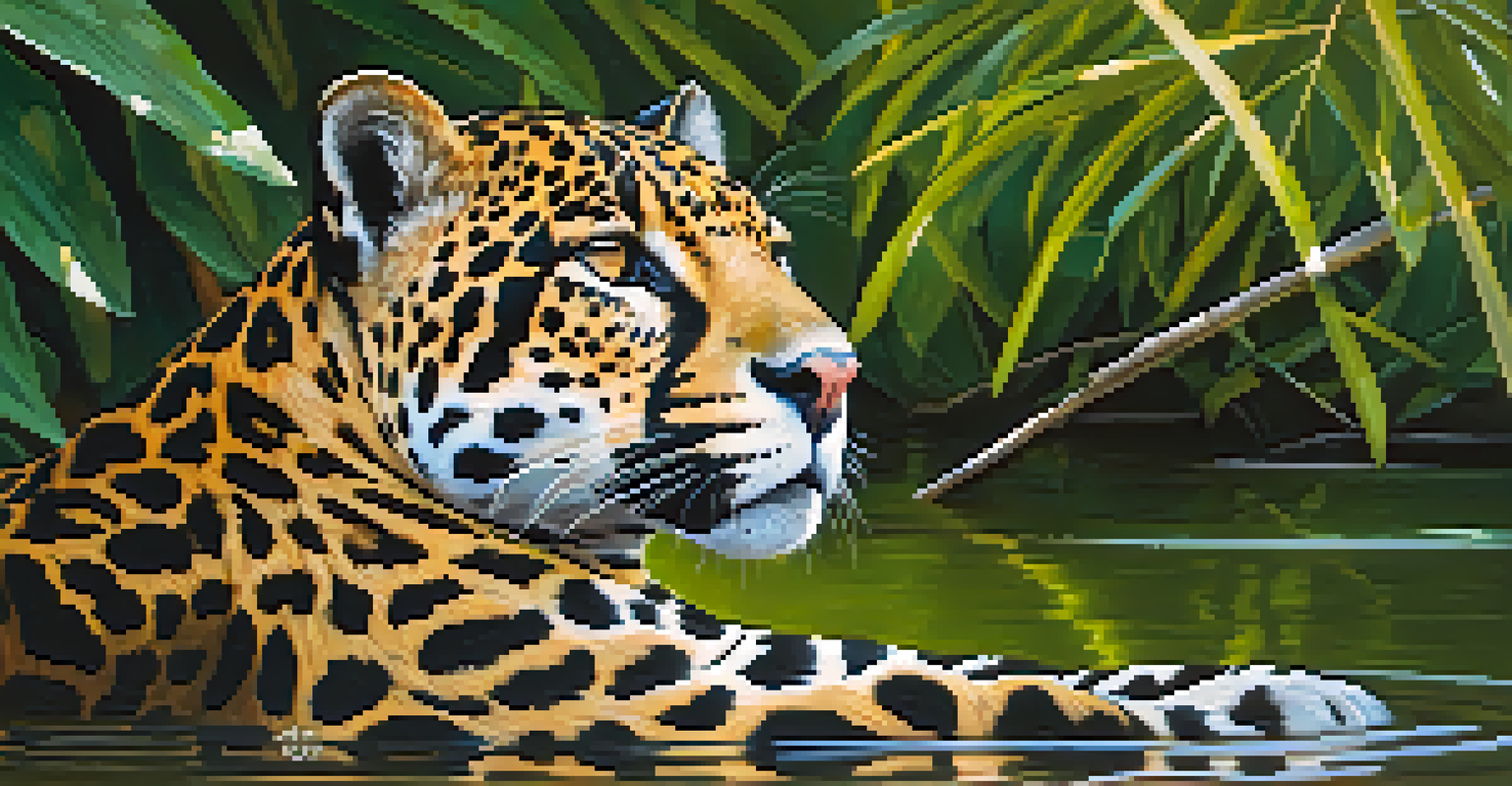Brazil's Pantanal: Geological Formations and Biodiversity

Understanding Brazil's Pantanal: An Overview
The Pantanal is the world's largest tropical wetland, sprawling across Brazil, Bolivia, and Paraguay. This expansive ecosystem is not just a feast for the eyes; it's a critical habitat for countless species. Covering approximately 150,000 square kilometers, the Pantanal showcases a stunning interplay of water and land, making it a unique geological feature.
The greatest threat to our planet is the belief that someone else will save it.
Geologically, the Pantanal is primarily characterized by its low-lying floodplains, which are shaped by seasonal rains and river systems. The region's unique topography creates a mosaic of habitats, ranging from marshes to woodlands, each supporting diverse flora and fauna. The geological formations have been shaped over millions of years, resulting in a dynamic landscape that evolves with the seasons.
As we dive deeper into the Pantanal, it's essential to appreciate its role as a biodiversity hotspot. The combination of varied habitats, water abundance, and climate creates an ideal environment for wildlife, making it one of the most biodiverse regions on the planet.
Geological Features of the Pantanal
The geological formations of the Pantanal are fascinating, characterized by sedimentary layers that have accumulated over millions of years. This sedimentary rock formation includes clays, silts, and sands that have been deposited by river systems, contributing to the area's unique soil composition. These geological layers not only shape the landscape but also influence the types of vegetation and animal life that thrive here.

One of the most notable features is the presence of ancient riverbeds and oxbow lakes, which are remnants of the region's changing waterways. These features create unique habitats that support a variety of aquatic and terrestrial species. For instance, these oxbow lakes are vital for fish reproduction, attracting migratory birds and providing food sources for larger predators.
Pantanal: A Biodiversity Hotspot
The Pantanal is home to thousands of species, making it one of the most biodiverse regions on the planet.
The seasonal flooding of the Pantanal further enhances its geological diversity. During the rainy season, vast areas become submerged, creating temporary wetlands that foster an explosion of life. This cyclical flooding is essential for maintaining the health of the ecosystem, allowing it to adapt and thrive despite the challenging conditions.
The Rich Biodiversity of the Pantanal
Home to thousands of species, the Pantanal is a biodiversity treasure trove. It supports over 1,000 species of birds, 400 species of mammals, and countless reptiles, amphibians, and fish. This diverse array of wildlife makes the Pantanal an essential site for conservation efforts and ecotourism, drawing nature lovers from around the globe.
In every walk with nature, one receives far more than he seeks.
One of the most iconic inhabitants is the jaguar, which roams the region's forests and wetlands. The Pantanal is considered one of the best places in the world to spot these elusive big cats. The presence of such apex predators indicates a healthy ecosystem, as they help maintain the balance of species within their habitats.
Beyond the jaguar, the Pantanal is also home to capybaras, caimans, and an incredible variety of birds like the hyacinth macaw. Each species plays a vital role in the ecosystem, contributing to the intricate web of life that defines the Pantanal's rich biodiversity.
Flora of the Pantanal: A Diverse Plant Kingdom
The flora of the Pantanal is as diverse as its fauna, featuring a range of plant species that have adapted to the unique wetland environment. From towering trees to aquatic plants, the vegetation varies significantly across different habitats. This diversity not only provides food and shelter for wildlife but also plays a crucial role in the overall health of the ecosystem.
The region is dominated by grasses, which thrive in the seasonal floodwaters, creating vast savannas that attract herbivores. Additionally, the Pantanal is home to unique plant species, such as the water lily and various orchids, which flourish in the wetter areas. These plants are not only beautiful but also serve as essential components of the food web.
Geological Diversity Shapes Ecosystem
The unique geological features of the Pantanal, including floodplains and oxbow lakes, create varied habitats essential for wildlife.
Moreover, the seasonal changes in the Pantanal significantly influence plant growth patterns. During the dry season, many plants go dormant, conserving resources until the rains return. This adaptability is a testament to the resilience of the flora, showcasing nature's remarkable ability to thrive in challenging conditions.
Climate and Its Influence on the Pantanal
The Pantanal experiences a tropical climate, characterized by distinct wet and dry seasons. The rainy season, from November to March, brings heavy downpours that flood the region, transforming it into a lush paradise. Conversely, the dry season, from April to October, sees water levels recede, exposing vast stretches of land and dramatically altering the landscape.
This climatic variability plays a pivotal role in shaping the biodiversity of the Pantanal. Many species have adapted to these seasonal changes, with some migrating to find food and others evolving to thrive in specific conditions. For example, migratory birds flock to the region during the rainy season, taking advantage of abundant food sources, while many mammals adjust their behaviors to cope with the changing environment.
Understanding the climate's impact on the Pantanal is essential for conservation efforts. As climate change poses new challenges, monitoring these shifts will help protect the unique ecosystems and the incredible wildlife that call this region home.
Conservation Challenges in the Pantanal
Despite its natural beauty, the Pantanal faces significant conservation challenges. Deforestation, agriculture, and urbanization threaten its delicate ecosystems and biodiversity. As land is cleared for farming and cattle ranching, important habitats are lost, putting numerous species at risk of extinction.
Additionally, climate change poses a growing threat to the Pantanal's unique environment. Altered rainfall patterns and increased temperatures can disrupt the delicate balance of the ecosystem, leading to changes in species distribution and habitat loss. Such challenges underscore the urgent need for proactive conservation strategies to safeguard this vital region.
Conservation Efforts Are Crucial
Despite its beauty, the Pantanal faces significant threats from deforestation and climate change, highlighting the need for proactive conservation strategies.
Efforts are underway to promote sustainable practices and raise awareness about the Pantanal's importance. Conservation organizations work tirelessly to protect critical habitats, while ecotourism initiatives encourage visitors to appreciate the region's beauty without harming it. By fostering a sense of stewardship, we can help ensure the Pantanal thrives for generations to come.
Experiencing the Pantanal: Ecotourism Opportunities
Ecotourism in the Pantanal offers a unique opportunity to experience its stunning landscapes and rich biodiversity. Visitors can explore the region through guided tours, wildlife watching, and even canoeing through its waterways. This immersive experience not only provides unforgettable memories but also supports local conservation efforts.
Many lodges and tour operators in the Pantanal prioritize sustainable practices, ensuring that tourism benefits both the environment and local communities. By choosing ecotourism, travelers contribute to protecting the ecosystems they enjoy while helping to preserve the region's cultural heritage. It's a win-win situation for both visitors and the Pantanal.

As travelers venture into the heart of the Pantanal, they can witness firsthand the incredible wildlife, from playful capybaras to soaring macaws. These experiences foster a deeper appreciation for nature and highlight the importance of conservation efforts in this remarkable ecosystem. In essence, ecotourism serves as a bridge connecting people with the natural world.